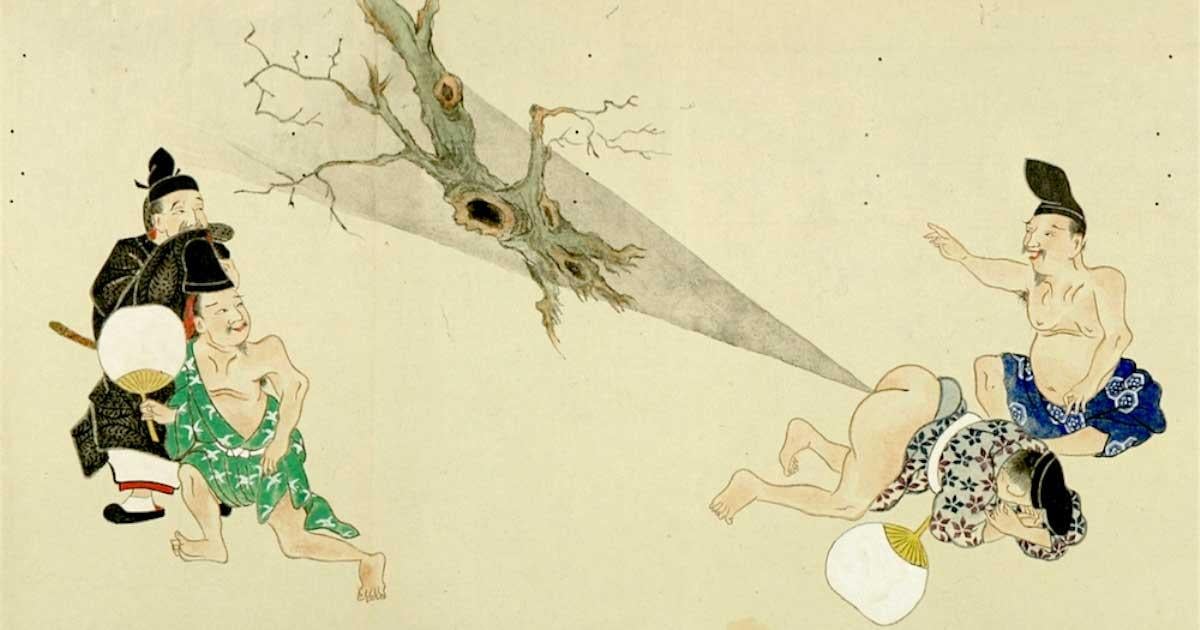
Ever heard of He Gassen? This quirky Japanese art form, also known as the "Fart Battle Scrolls," dates back to the Edo period. He Gassen depicts humorous scenes of people engaged in flatulence battles. These scrolls are not just funny; they offer a glimpse into the culture and humor of ancient Japan. Imagine samurais, farmers, and townsfolk all caught in the act of, well, passing gas! Why did they create such art? Some believe it was a way to mock political figures or express social commentary. Others think it was simply for laughs. Curious to know more? Let's dive into 37 fascinating facts about He Gassen!
Key Takeaways:
- He Gassen, a humorous Japanese scroll painting from the Edo period, showcases farting contests and reflects the timeless nature of humor and artistic expression.
- This quirky artwork, He Gassen, not only entertains with its fart battles but also offers valuable insights into Japanese history, culture, and the freedom of artistic expression.
What is He Gassen?
He Gassen, also known as the "Fart Battle," is a unique and humorous piece of Japanese art. This scroll painting dates back to the Edo period, showcasing a series of scenes where people engage in farting contests. Let's dive into some fascinating facts about this quirky artwork.
-
Historical Context: He Gassen was created during the Edo period (1603-1868), a time when Japan experienced significant cultural and artistic growth.
-
Medium: The artwork is a scroll painting, a traditional Japanese art form that involves painting on a long roll of paper or silk.
-
Humor in Art: He Gassen reflects the humor and satire prevalent in Edo-period art, poking fun at social norms and behaviors.
-
Unknown Artist: The creator of He Gassen remains anonymous, adding an air of mystery to this already intriguing piece.
-
Cultural Significance: The painting offers insight into the daily life and humor of Edo-period Japan, showing that even centuries ago, people enjoyed a good laugh.
The Scenes in He Gassen
The scroll is divided into several scenes, each depicting different aspects of the fart battle. Here are some interesting details about these scenes.
-
Variety of Characters: The scroll features a diverse cast of characters, including samurai, monks, and commoners, all participating in the fart battle.
-
Detailed Expressions: The artist paid close attention to the facial expressions and body language of the characters, capturing their reactions to the farting.
-
Use of Props: Some scenes include props like fans and umbrellas, which characters use to either direct or shield themselves from the farts.
-
Outdoor Setting: Most of the scenes take place outdoors, suggesting that the fart battles were public spectacles.
-
Interaction with Nature: In some parts of the scroll, characters are shown farting at animals or plants, adding a whimsical touch to the artwork.
Symbolism and Interpretation
While He Gassen is humorous, it also carries deeper meanings and symbolism. Let's explore some interpretations of this unique artwork.
-
Social Commentary: The painting may serve as a critique of social hierarchies and the absurdity of certain customs.
-
Political Satire: Some scholars believe that He Gassen mocks political figures or events of the time, using humor to convey dissent.
-
Human Nature: The artwork highlights the universality of bodily functions, reminding viewers that everyone, regardless of status, shares common human experiences.
-
Cultural Taboo: Farting was considered a taboo subject, and He Gassen's focus on it challenges societal norms and encourages open discussion.
-
Artistic Freedom: The scroll exemplifies the freedom artists had during the Edo period to explore unconventional and humorous themes.
Preservation and Legacy
He Gassen has survived for centuries, and its preservation offers valuable insights into Japanese art and culture. Here are some facts about its legacy.
-
Museum Exhibits: The scroll has been displayed in various museums, allowing the public to appreciate its historical and artistic value.
-
Digital Archives: High-quality digital scans of He Gassen are available online, ensuring its accessibility to a global audience.
-
Academic Research: Scholars continue to study He Gassen, uncovering new interpretations and historical contexts.
-
Pop Culture Influence: The artwork has inspired modern artists and creators, appearing in various forms of media and entertainment.
-
Cultural Heritage: He Gassen is considered an important part of Japan's cultural heritage, reflecting the humor and creativity of the Edo period.
Fun Facts about He Gassen
Beyond its historical and cultural significance, He Gassen is full of fun and quirky details. Here are some lesser-known facts.
-
Length of the Scroll: The scroll measures approximately 34 feet long, providing ample space for the detailed scenes.
-
Multiple Copies: Several copies of He Gassen exist, suggesting that it was a popular and widely circulated piece of art.
-
Influence on Manga: The humorous and exaggerated style of He Gassen has influenced modern manga and anime.
-
Educational Tool: Some educators use He Gassen to teach students about Edo-period art and culture in a fun and engaging way.
-
Artistic Techniques: The scroll showcases traditional Japanese painting techniques, including the use of ink and color washes.
He Gassen in Modern Times
He Gassen continues to capture the imagination of people today. Let's look at how this ancient artwork remains relevant in modern times.
-
Internet Sensation: He Gassen gained renewed popularity with the advent of the internet, where it quickly became a viral sensation.
-
Memes and Parodies: The artwork has inspired countless memes and parodies, bringing its humor to a new generation.
-
Cultural Festivals: Some Japanese cultural festivals feature reenactments or displays of He Gassen, celebrating its historical significance.
-
Artistic Inspiration: Contemporary artists draw inspiration from He Gassen, creating new works that pay homage to the original scroll.
-
Educational Programs: Museums and cultural institutions offer educational programs centered around He Gassen, promoting an understanding of Edo-period art.
The Impact of He Gassen
The lasting impact of He Gassen on art and culture is undeniable. Here are some ways this unique artwork has influenced the world.
-
Art History: He Gassen is studied as an important example of Edo-period art, contributing to our understanding of Japanese history.
-
Cultural Exchange: The artwork has facilitated cultural exchange, introducing people worldwide to Japanese humor and artistic traditions.
-
Humor in Art: He Gassen demonstrates the timeless nature of humor, showing that laughter transcends cultural and historical boundaries.
-
Artistic Expression: The scroll encourages artists to explore unconventional themes and push the boundaries of traditional art.
-
Public Engagement: He Gassen's popularity has sparked public interest in Japanese art and culture, leading to increased museum attendance and cultural appreciation.
-
Preservation Efforts: The artwork's significance has led to efforts to preserve and protect other historical pieces, ensuring their longevity for future generations.
-
Cultural Identity: He Gassen is a testament to the rich cultural identity of Japan, highlighting the creativity and humor that define its artistic heritage.
Final Thoughts on He Gassen
He Gassen, or the "Fart Battle" scroll, offers a quirky glimpse into Japanese humor from centuries ago. This unique artwork, created during the Edo period, showcases a playful side of history often overshadowed by more serious events. The scroll's detailed illustrations of people engaged in farting contests highlight the universal nature of humor, transcending time and culture. While it might seem odd to modern eyes, He Gassen reminds us that laughter and light-heartedness have always been part of human life. Whether you're a history buff or just someone who enjoys a good laugh, this scroll is a fascinating piece of art worth exploring. It’s a testament to the fact that even in the past, people found joy in the simplest, most unexpected things. So next time you need a chuckle, remember He Gassen and its timeless humor.
Frequently Asked Questions
Was this page helpful?
Our commitment to delivering trustworthy and engaging content is at the heart of what we do. Each fact on our site is contributed by real users like you, bringing a wealth of diverse insights and information. To ensure the highest standards of accuracy and reliability, our dedicated editors meticulously review each submission. This process guarantees that the facts we share are not only fascinating but also credible. Trust in our commitment to quality and authenticity as you explore and learn with us.


